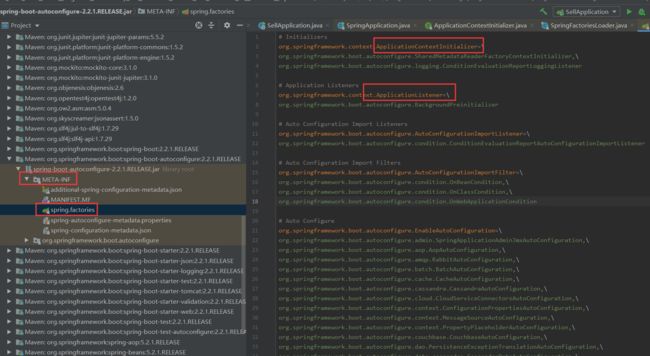个人博客:haichenyi.com。感谢关注
需要搞清楚几个重要的事件回调机制
配置在META-INF/spring.factories
- ApplicationContextInitializer
- SpringApplicationRunListener
只需要放在ioc容器中
ApplicationRunner
CommandLineRunner
新建一个空项目,就勾选web,找到启动类,每个方法上面写的注释,可以看一下:
@SpringBootApplication
public class SellApplication {
public static void main(String[] args) {
SpringApplication.run(SellApplication.class, args);
}
}
//上面run方法点进来
public static ConfigurableApplicationContext run(Class primarySource, String... args) {
return run(new Class[] { primarySource }, args);
}
public static ConfigurableApplicationContext run(Class[] primarySources, String[] args) {
return new SpringApplication(primarySources).run(args);
}
看到这里,就应该看到了,启动流程分为两步
- 创建SpringApplication对象
- 运行run方法
创建SpringApplication对象
//上面的构造方法点进去
//这里与1.5版本不一样的地方就是,
//2.X这里调用了重载的构造方法,而1.5这里调用的是一个initialize()方法,这个方法里面的内容,与下面两个参数的重载方法差不多
public SpringApplication(Class... primarySources) {
this(null, primarySources);
}
//下面这个就是this调用的重载的构造方法
@SuppressWarnings({ "unchecked", "rawtypes" })
public SpringApplication(ResourceLoader resourceLoader, Class... primarySources) {
this.resourceLoader = resourceLoader;
//保存主配置类,1.5里面这里有个非空判断,用if做的,这里换成的断言做判断
Assert.notNull(primarySources, "PrimarySources must not be null");
this.primarySources = new LinkedHashSet<>(Arrays.asList(primarySources));
//判断当前是否一个web应用
this.webApplicationType = WebApplicationType.deduceFromClasspath();
//从类路径下找到META‐INF/spring.factories配置的所有ApplicationContextInitializer;然后保存起 来
setInitializers((Collection) getSpringFactoriesInstances(ApplicationContextInitializer.class));
//从类路径下找到ETA‐INF/spring.factories配置的所有ApplicationListener
setListeners((Collection) getSpringFactoriesInstances(ApplicationListener.class));
//从多个配置类中找到有main方法的主配置类
this.mainApplicationClass = deduceMainApplicationClass();
}
setInitializers()方法
看方法名就知道,这个是初始化方法,初始化什么东西呢?再看传的参数ApplicationContextInitializer,就是一开始我们提到的类。我们看这个是怎么获取的
//第一步:
private SpringApplicationRunListeners getRunListeners(String[] args) {
Class[] types = new Class[] { SpringApplication.class, String[].class };
return new SpringApplicationRunListeners(logger,
getSpringFactoriesInstances(SpringApplicationRunListener.class, types, this, args));
}
//第二步:
private Collection getSpringFactoriesInstances(Class type, Class[] parameterTypes, Object... args) {
ClassLoader classLoader = getClassLoader();
// Use names and ensure unique to protect against duplicates
//看这里的导入方法SpringFactoriesLoader.loadFactoryNames(type, classLoader)
Set names = new LinkedHashSet<>(SpringFactoriesLoader.loadFactoryNames(type, classLoader));
List instances = createSpringFactoriesInstances(type, parameterTypes, classLoader, args, names);
AnnotationAwareOrderComparator.sort(instances);
return instances;
}
//第三步:
public static List loadFactoryNames(Class factoryType, @Nullable ClassLoader classLoader) {
String factoryTypeName = factoryType.getName();
return loadSpringFactories(classLoader).getOrDefault(factoryTypeName, Collections.emptyList());
}
//第四步,就是这里了。看这里面的实现
private static Map> loadSpringFactories(@Nullable ClassLoader classLoader) {
MultiValueMap result = cache.get(classLoader);
if (result != null) {
return result;
}
try {
//一眼看过去。很明显,这里就是classLoader.getResources(),导入的本地的资源。看这个传的参数,我放到这个方法下面去了
Enumeration urls = (classLoader != null ?
classLoader.getResources(FACTORIES_RESOURCE_LOCATION) :
ClassLoader.getSystemResources(FACTORIES_RESOURCE_LOCATION));
result = new LinkedMultiValueMap<>();
//这里通过一个while循环,加载本地配置的ApplicationContextInitializer
while (urls.hasMoreElements()) {
URL url = urls.nextElement();
UrlResource resource = new UrlResource(url);
Properties properties = PropertiesLoaderUtils.loadProperties(resource);
for (Map.Entry entry : properties.entrySet()) {
String factoryTypeName = ((String) entry.getKey()).trim();
for (String factoryImplementationName : StringUtils.commaDelimitedListToStringArray((String) entry.getValue())) {
result.add(factoryTypeName, factoryImplementationName.trim());
}
}
}
cache.put(classLoader, result);
return result;
}
catch (IOException ex) {
throw new IllegalArgumentException("Unable to load factories from location [" +
FACTORIES_RESOURCE_LOCATION + "]", ex);
}
}
/**
* The location to look for factories.
* Can be present in multiple JAR files.
*/
public static final String FACTORIES_RESOURCE_LOCATION = "META-INF/spring.factories";
所以,从上面的源码,我们一步一步点击进去看,我们就能发现,他最终都是加载到 META-INF/spring.factories 目录下的 ApplicationContextInitializer 当然,到目前为止这里只是初始化
setListeners()方法
一眼就能看出来,这里是设置监听方法
setListeners((Collection) getSpringFactoriesInstances(ApplicationListener.class));
一眼看过去,这个setListener方法传的参数熟不熟悉?就是我们上面初始化的时候传的参数是同一个方法。所以,这里设置监听设置哪些监听方法也是META-INF/spring.factories 目录下的listener方法,我们看一下这个文件内容:
这些都是是自动配置类的内容
运行Run方法
public ConfigurableApplicationContext run(String... args) {
StopWatch stopWatch = new StopWatch();
stopWatch.start();
ConfigurableApplicationContext context = null;
Collection exceptionReporters = new ArrayList<>();
configureHeadlessProperty();
//获取SpringApplicationRunListeners;从类路径下META‐INF/spring.factories
SpringApplicationRunListeners listeners = getRunListeners(args);
//回调所有的获取SpringApplicationRunListener.starting()方法
listeners.starting();
try {
//封装命令行参数
ApplicationArguments applicationArguments = new DefaultApplicationArguments(args);
//准备环境,创建环境完成后回调SpringApplicationRunListener.environmentPrepared();表示环境准 备完成
ConfigurableEnvironment environment = prepareEnvironment(listeners, applicationArguments);
//这里是新增的,点击去看,就是再properties文件中配置你需要忽略的bean
configureIgnoreBeanInfo(environment);
//这个是打印spring的logo banner图
Banner printedBanner = printBanner(environment);
/创建ApplicationContext;这个下面有下介绍
context = createApplicationContext();
//看一下参数,这个就是做异常报告处理的
exceptionReporters = getSpringFactoriesInstances(SpringBootExceptionReporter.class,
new Class[] { ConfigurableApplicationContext.class }, context);
//准备上下文环境;将environment保存到ioc中;而且applyInitializers();
//applyInitializers():回调之前保存的所有的ApplicationContextInitializer的initialize方法
//回调所有的SpringApplicationRunListener的contextPrepared();
//prepareContext运行完成以后回调所有的SpringApplicationRunListener的contextLoaded();
prepareContext(context, environment, listeners, applicationArguments, printedBanner);
//s刷新容器;ioc容器初始化(如果是web应用还会创建嵌入式的Tomcat);Spring注解版
//扫描,创建,加载所有组件的地方;(配置类,组件,自动配置)
refreshContext(context);
//2.x里面是空方法
afterRefresh(context, applicationArguments);
stopWatch.stop();
if (this.logStartupInfo) {
new StartupInfoLogger(this.mainApplicationClass).logStarted(getApplicationLog(), stopWatch);
}
listeners.started(context);
//从ioc容器中获取所有的ApplicationRunner和CommandLineRunner进行回调 //ApplicationRunner先回调,CommandLineRunner再回调
callRunners(context, applicationArguments);
}
catch (Throwable ex) {
handleRunFailure(context, ex, exceptionReporters, listeners);
throw new IllegalStateException(ex);
}
try {
listeners.running(context);
}
catch (Throwable ex) {
handleRunFailure(context, ex, exceptionReporters, null);
throw new IllegalStateException(ex);
}
//返回这个IOC容器
return context;
}
getRunListeners()方法
我们看到上面第一个有注释的位置:getRunListeners方法
private SpringApplicationRunListeners getRunListeners(String[] args) {
Class[] types = new Class[] { SpringApplication.class, String[].class };
return new SpringApplicationRunListeners(logger,
getSpringFactoriesInstances(SpringApplicationRunListener.class, types, this, args));
}
方法熟悉吗?就是我们上面初始化的时候调用的那个方法,只是这里的参数传的是:SpringApplicationRunListener,我们看最开始说的,这就是我们要了解的第二个内容,回调都是怎么调用的
方法里面的注释也写了,先获取监听事件,然后回调starting方法,我们看一下这个接口有那些回调方法:
public interface SpringApplicationRunListener {
default void starting() {
}
default void environmentPrepared(ConfigurableEnvironment environment) {
}
default void contextPrepared(ConfigurableApplicationContext context) {
}
default void contextLoaded(ConfigurableApplicationContext context) {
}
default void started(ConfigurableApplicationContext context) {
}
default void running(ConfigurableApplicationContext context) {
}
default void failed(ConfigurableApplicationContext context, Throwable exception) {
}
}
就这些回调,这里还用了1.8的新特性,default关键字,接口里面的方法可以有方法体
prepareEnvironment()
看到第二个写注释的位置,眼熟吗?可不就是跟上面回调方法名字相同么?我们点进去看一下
private ConfigurableEnvironment prepareEnvironment(SpringApplicationRunListeners listeners,
ApplicationArguments applicationArguments) {
// Create and configure the environment
ConfigurableEnvironment environment = getOrCreateEnvironment();
configureEnvironment(environment, applicationArguments.getSourceArgs());
ConfigurationPropertySources.attach(environment);
//这里划重点,这里就调用的environmentPrepared的回调方法
listeners.environmentPrepared(environment);
bindToSpringApplication(environment);
if (!this.isCustomEnvironment) {
environment = new EnvironmentConverter(getClassLoader()).convertEnvironmentIfNecessary(environment,
deduceEnvironmentClass());
}
ConfigurationPropertySources.attach(environment);
return environment;
}
准备完环境之后,调用environmentPrepared的回调
createApplicationContext()
protected ConfigurableApplicationContext createApplicationContext() {
Class contextClass = this.applicationContextClass;
if (contextClass == null) {
try {
switch (this.webApplicationType) {
case SERVLET:
contextClass = Class.forName(DEFAULT_SERVLET_WEB_CONTEXT_CLASS);
break;
case REACTIVE:
contextClass = Class.forName(DEFAULT_REACTIVE_WEB_CONTEXT_CLASS);
break;
default:
contextClass = Class.forName(DEFAULT_CONTEXT_CLASS);
}
}
catch (ClassNotFoundException ex) {
throw new IllegalStateException(
"Unable create a default ApplicationContext, please specify an ApplicationContextClass", ex);
}
}
return (ConfigurableApplicationContext) BeanUtils.instantiateClass(contextClass);
}
创建applicationContext,这里跟1.5不一样,1.5就只有两种:一种是web的ioc容器,一种是默认的ioc容器。2.X这里有三种:DEFAULT_CONTEXT_CLASS,DEFAULT_SERVLET_WEB_CONTEXT_CLASS,DEFAULT_REACTIVE_WEB_CONTEXT_CLASS,实际字符串比较长,可以去看一下源码。然后用BeanUtils通过反射创建。
prepareContext()方法
private void prepareContext(ConfigurableApplicationContext context, ConfigurableEnvironment environment,
SpringApplicationRunListeners listeners, ApplicationArguments applicationArguments, Banner printedBanner) {
//将environment放到context中
context.setEnvironment(environment);
postProcessApplicationContext(context);
//初始化
applyInitializers(context);
//这里回调contextPrepared方法
listeners.contextPrepared(context);
if (this.logStartupInfo) {
logStartupInfo(context.getParent() == null);
logStartupProfileInfo(context);
}
// Add boot specific singleton beans
ConfigurableListableBeanFactory beanFactory = context.getBeanFactory();
beanFactory.registerSingleton("springApplicationArguments", applicationArguments);
if (printedBanner != null) {
beanFactory.registerSingleton("springBootBanner", printedBanner);
}
if (beanFactory instanceof DefaultListableBeanFactory) {
((DefaultListableBeanFactory) beanFactory)
.setAllowBeanDefinitionOverriding(this.allowBeanDefinitionOverriding);
}
if (this.lazyInitialization) {
context.addBeanFactoryPostProcessor(new LazyInitializationBeanFactoryPostProcessor());
}
// Load the sources
Set准备上下文环境;将environment保存到ioc中;而且applyInitializers()
protected void applyInitializers(ConfigurableApplicationContext context) {
for (ApplicationContextInitializer initializer : getInitializers()) {
Class requiredType = GenericTypeResolver.resolveTypeArgument(initializer.getClass(),
ApplicationContextInitializer.class);
Assert.isInstanceOf(requiredType, context, "Unable to call initializer.");
initializer.initialize(context);
}
}
这里就将我们一开始从配置文件里面读取,然后创建ApplicationContextInitializer初始化。
当环境准备好之后,就回调了SpringApplicationRunListener的contextPrepared();
当所有的都准备好了之后,回调SpringApplicationRunListener的contextLoaded();
到这里,所有的环境都准备好了,需要打印的logo也加进去了。
refreshContext()
刷新容器这个方法,我们可以点到具体的功能实现里面,可以看到,这里就是扫描,创建,加载所有的组件,配置类,组件,自动配置等。
到这里,这个方法创建完之后,所有的控制器就创建完了,所有的组件,bean等,都在控制台打印出来了。如果是web应用,还会创建嵌入式的tomcat。我们spring boot项目内嵌tomcat,就是在这里创建的。
afterRefresh()
1.5版本这个方法里面回调的是callRunners方法,而2.X版本,现在这是个空方法里面并没有实现。callRunners被提出来了,放到了最后面。
started(),running()
在1.5版本这里,也就是afterRefresh()之后,应该是调用的SpringApplicationRunListeners的finished()方法。
在2.X版本之后,去掉了finished方法,改成了调用started方法,然后调用running方法。我们上面有一个starting方法,从这里名字就可以看出来,相当于,首先是正在启动当中,然后就是启动完成了,正在运行了。
callRunners()
private void callRunners(ApplicationContext context, ApplicationArguments args) {
List从IOC容器中(不是配置文件)获取所有的的ApplicationRunner和CommandLineRunner进行回调。这也是最开始说的两个注意的地方
并且,这里有个先后顺序,先回调的ApplicationRunner,后回调的CommandLineRunner
这里也是run方法,最后执行的地方。从这里就是真正的开启了run。
最后一步,返回那个context就是返回IOC容器对象。到这里,我们的spring boot就启动完成了。
这就是我们的spring boot的启动原理。初始化,listener的回调,Runner的回调都说的很清楚。
